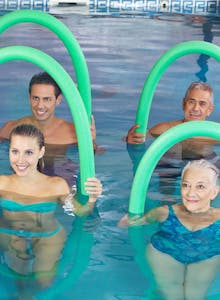
Kernersville Rehab Specialists is pleased to be able to offer Aquatic Physical Therapy within our facility. This provides an opportunity for our patients that many other rehabilitation facilities cannot match. Having our own pool enables us to combine aquatic therapy with a multitude of "land-based" treatment activities and modality options all during the same treatment session. You receive better therapy, better value.
Designed for therapy, the pool is heated to 92° to provide a relaxing, healing environment. It is equipped with a 400 pound capacity chair-lift for transfer of patients with limited mobility. Patients of all ages and activity levels (severely de-conditioned to the competitive athlete) can benefit from Aquatic Physical Therapy. Swimming skills are not required.
What is Aquatic Physical Therapy?
It is a medically-based therapy program designed to improve specific aspects of a patient's functional abilities through use of the pool. This program uses the properties of water to achieve results not attainable for most patients in any other environment.
Water is an excellent base for exercise, providing an anti-stress environment for movement. For initial therapy, gentle water exercises use the water's resistance to build muscle strength and flexibility. Water exercise can be performed more easily by people who find lifting weights, or even weight bearing exercise, difficult or painful on dry land. Water also provides buoyancy and support for the body. When in shoulder deep water, a person only has to support 10% of actual body weight. Exercising in the pool allows greater range of motion without joint pain, or joint re-injury.
The warmer water of the therapy pool induces vasodilation, which draws blood into the target tissues. The increased blood flow delivers oxygen and nutrients to the tissues while removing cell wastes. This helps promote faster healing of injured tissues. The warmth also decreases muscle spasm, relaxes tense muscles, relieves pain, and reduces swelling.
There are two distinct types of water-based programs, each with a different purpose as summarized below.
- Designed specifically for each patient and diagnosis.
- Designed to progress toward specific functional goals.
- Individualized program.
- Medically-based: requires Physician's order, licensed rehab therapist for care.
- Reimbursable through most medical insurers.
- Designed as general conditioning for individuals with limited mobility.
- Designed to maintain or improve general conditioning.
- Group setting.
- Does not require a Physician's order.
- Not reimbursable.
- Ideal for a maintenance program after discharge from therapy.
How Does Aquatic Physical Therapy Work?
Water has unique properties that make performing therapy activities either easier or more challenging, depending on the need. These properties include:
Buoyancy (assistive, resistive, supportive) - reduces the majority of body weight on painful, injured or surgically repaired tissues, joints, and bones. This allows the patient to regain increased range of motion without the pain associated with full weight bearing. It also allows starting rehabilitation much sooner after injury or surgery. In shoulder deep water, body weight is effectively reduced by as much as 90%.
Hydrostatic pressure - mild water pressure helps reduce localized edema following tissue injury. Supporting the body, water pressure also helps joint stability and reduces risk of injury from falls.
Resistance - varies by the force (velocity) of motion. Increased force against water produces more resistance, which increases muscle effort, thereby increasing muscle strength and tone. Initial rehabilitation involves light resistance, progressively increasing as muscles strengthen. Resistance can be gravity assisted or resisted, buoyancy assisted or resisted.
Specific heat of the water - cooler water (82-90°) is used to dissipate body heat during conditioning and training. Warmer water (87-92°) is used during rehabilitation to increase body heat for increased circulation, muscle relaxation and pain relief.
Benefits of Aquatic Physical Therapy
- Decreases pain.
- Allows easier movement of painful joints.
- Decreases muscle spasm and rigidity, promoting relaxation.
- Decreases joint compression forces (impact) and allows for limited, early weight bearing.
- Increases joint flexibility and range of motion.
- Increases muscular strength and endurance.
- Decreases peripheral edema/swelling.
- Increases peripheral circulation.
- Increases cardiovascular endurance.
- Improves balance and coordination.
- Improves trunk stability and posture.
- Increases patient morale and confidence (psychological effects).
Who Benefits from Aquatic Physical Therapy?
Patients with:
- Arthritis
- Fibromyalgia
- Compression and Other Fractures
- Chronic Pain
- Stroke
- Spinal Cord/Head Injury
- Prenatal
- Orthopedic Problems
- Severe Weakness
- Obesity
- Neurological Problems
- Trauma
- Industrial Injury
- Sports Injury
- Fall Risk/Balance/
Gait Problems - Pre- and Post-operative
- Osteoporosis
- Back and Neck Pain
- Joint Replacement
Aquatic Physical Therapy Program Components
- Initial evaluation, assessment, mutual determination of treatment goals and plan
- Aquatic exercise program (warm-up, stretching, strengthening and endurance, relaxation)
- Complementary land based therapies (physical modalities, gait training, functional strength exercises, balance exercises, endurance exercises)
- Continuous re-evaluation of patient's response to treatment, adjusting plan accordingly
- Providing therapy goals and progress notes to referring physician
- Patient education
- Home and discharge programs:
- Designed to allow patient to continue with exercises between visits and after discharge
- Encouraging a life style change and self motivation to continue to progress independently
